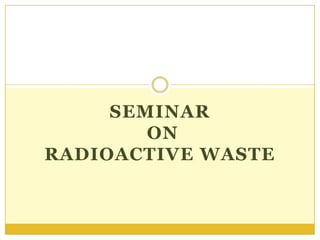
Seminar on Radioactive Waste Presentation
- 2. Radioactive Waste We will discuss – Radioactivity Low Level Radioactive Waste High Level Radioactive Waste Mining Tailings
- 3. Radioactivity Atom is the smallest unit of an element. It is made up of a nucleus containing proton and neutron surrounded by electrons. In the nucleus of an ordinary atom the no. of neutron is equal to no. of protons. Such a nucleus is known a stable nucleus. If the no. of neutron and proton are not equal in a nucleus then it is called Unstable Nucleus. Radioactive nuclides continue to decay releasing radioactive radiations or RADIOACTIVITY.
- 4. Low Level Radioactive Waste LLRW are generated when uranium is extracetd and prepared for nuclear fuel. They are produced in frequent operations of nuclear power plants (core water exchange, maintenance and cleanup operation etc). They are generated from:- - Research laboratories - Hospitals - Diagnostic Centers - Army Ammunition Plants etc. Low Level Radioactive waste consists of microcurie, millicurie and at times curie activity waste. (A Curie is a unit of nuclear transformations. 1 Curie is 3.7 x1010 transformations per second)
- 5. Low level radioactive waste consists of: Contaminated solids Liquids Animal carcasses Small sealed sources Wash water coming from nuclear powerplant
- 6. Classification of LLRW Class A low-level radioactive waste is the least hazardous, containing mostly short-lived radionuclides that will be reduced in radioactivity (decay) in a relatively short time. It contains only small amounts of radionuclides that take a relatively short time to decay. Class A waste will be disposed of in concrete canisters that will maintain their shape and strength for hundreds of years.
- 7. Classification of LLRW (Contd.) Class B low-level radioactive waste is more hazardous than Class A waste. Most of it comes from nuclear reactors. It must be in a stable form for disposal and will also be disposed of in concrete canisters. Stabilization can be accomplished by solidifying liquid waste, compacting solid waste, or placing the low-level radioactive waste in a container that will be stable for many years. Class B low-level radioactive waste makes up only a small percent of the waste volume generated; but along with Class C waste, it contains the largest portion of the total radioactivity.
- 8. Classification of LLRW (Contd.) Class C low-level radioactive waste is the most hazardous and must be handled accordingly. It has the highest degree of radioactivity among the low level radioactive wastes. It also must be disposed of in a stable form.
- 9. Volume of Waste Generated.
- 10. Volume of waste generated
- 11. Treatment of low level waste Radioactive animal carcasses are either incinerated or buried onsite. Low level contaminated solid wastes are buried. Solid wastes are “Super compacted” at 30,000 psi to reduce the volume to be buried. Sewer Disposed (Regulations allow curie levels of some isotopes to be sewer disposed of if dilution is large enough). LLRW are also treated by precipitation, filtration, ion exchange and thermal evaporation.
- 12. Disposal of LLRW For safe disposal LLRW are stored in water tight R.C.C. containers. Before placing in containers, the volume is reduced by techniques like evaporation, and incineration and compression. Discharge in open sea bed. Emphasis is always on recycling and containment in containers placed in safe deposit vaults.
- 13. Disposal of LLRW (Contd.) Small sealed sources are “Stabilized” in concrete and buried. Stabilized concrete is concrete that is certified to resist wear for a certain time period.
- 14. Discharge of LLRW in to the sea As the chemical reprocessing is very costly the LLRW is dumped into the sea. Provisions of International Commission for Radiological Protection(ICRP): - Public must never be exposed to levels above the ICRP recommended limits. - Keeping cost in mind, doses should be kept as far below the mandatory limits as possible.
- 15. High-Level Radioactive Waste (HLRW) High-Level Radioactive Waste is the irradiated fuel from the cores of nuclear reactors, the liquid and sludge wastes that are left over after irradiated fuel has been reprocessed (a procedure used to extract uranium and plutonium), the solid that would result from efforts to solidify that liquid and sludge from reprocessing. • The most dangerous radioactive waste. • Spent fuel comes from nuclear reactors (52,000 tons). • Liquid and solid waste from plutonium production (91 million gallons). • About 70 percent of the available storage space is now filled with used fuel assemblies at Turkey Point. • It is measured in curies per litre.
- 16. High Level Radioactive Waste (contd.) This usually contains plutonium 239 which have half life period of 24000 years. It have great difficulties in disposal. Require careful handling and treatment.
- 17. Disposal of HLRW The technology of isotope separation is used. Plutonium-239 is separated from Uranium- 238. Before HLRW are solidify they are usually stored in underground multilayered thick concrete tanks for about five years. They are kept in especially designed containers. They are buried in deep disposal sites. Favoured sites are bedded salt, basalt or gneiss, where it is believed that these waste will maintain their integrity. The only place for long time holding of HLRW in USA is Yucca mountains in Nevada deserts.
- 18. Mill Tailing These wastes are the residues, remaining after the processing of natural ore to extract uranium & thorium. The radioactivity is higher than LLRW and lower than those of HLRW. They are often classified as Intermediate level wastes. Measured in millicuries per litre. They are generated in large quantities, and finally disposed of with LLRW after some treatments.
- 19. Transuranic Waste Transuranic waste contains manmade elements heavier than uranium, such as plutonium, hence the name “trans” or “beyond” uranium. Half life of TUW is greater than 20 years. Transuranic waste primarily consists of clothing, tools, rags, residues, soil, and debris. They are categorized as:- - Contact Handle (CH) - Remote Handle (RH)
- 21. Thank You..!!!